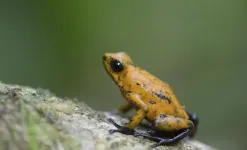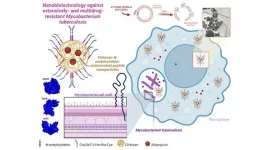(Press-News.org) Fish from the same species can evolve their sense of smell and display individual foraging ‘personalities’ to successfully find food in different habitats, according to new research.
In the study, published today as a Reviewed Preprint in eLife, researchers developed a high-throughput behavioural assay to test spontaneous swimming and differences in the sense of smell of individual Mexican cavefish larvae. eLife editors described the work as important, presenting compelling evidence that the surface and cave morphs of the fish show different olfactory preferences and odour sensitivities, and that individual fish show substantial variability in their spontaneous activity that is relevant for olfactory behaviour.
“With more than 26,000 species representing half of all vertebrates, bony fishes are extremely diverse and have colonised all possible ecological niches, through their ability to adapt their sensory systems,” says lead author Maryline Blin, a Research Engineer at Paris-Saclay Institute of Neuroscience (NeuroPSI – CNRS, Université Paris-Saclay), France. Yet, although the comparative anatomy of fish brains is well documented, behavioural studies have mainly focused on a few model species such as zebrafish. The links between how fish sensory systems evolve and resulting fish behaviour remain poorly understood and hinder cross-species comparisons.
To study the evolution of smell-driven behaviours in a laboratory setting, the researchers chose two closely related fish of the Mexican tetra species – the blind cave-dwelling subtype, and its sighted surface river-dwelling counterpart. Cavefish have larger olfactory pits (the ‘nose’ tissue) and different nerve composition than their surface-dwelling relatives, but their genetic make-up related to smell is thought to be similar. This led the team to test a hypothesis that the superior sense of smell in the cave-dwelling fish is an adaptive trait that facilitated their survival in their extreme subterranean habitat. To test this, they observed behaviours of individual fish in response to different food odours, comparing the swimming patterns of the surface and cave-dwelling subtypes.
After studying baseline swimming patterns, the team tested their response to different amino acid ‘foods’. Alanine, a potent food cue for most fish species, induced a strong behavioural response in cave-dwelling fish, decreasing the number of back-and-forth swims, slowing down swimming and shifting swimming activity towards the source of the amino acid. By contrast, the surface-dwelling fish responses were more subtle and displayed by only some individuals; there was no major shift in terms of back-and-forth swimming or swimming speed. Together, this suggests the detection threshold for the food source and subsequent behavioural response have significantly evolved in the cave-dwelling fish.
In addition to studying population-level behaviour changes by the fish, the team also studied how individual fish responded to food sources. Although cave-dwelling fish all behaved in a stereotypical manner for the strong odorant alanine, the team observed individual differences in the response of both cave and surface-dwelling fish in response to other amino acid odours. They explored this further by looking at how behaviour changed relative to individual baseline swimming preferences. This revealed that surface-dwelling fish with a lower baseline swimming speed were better able to smell several of the odours. This was not the case for cave-dwelling fish. For them, a special swimming pattern all around the test box was predictive of good olfactory scores for sense of smell. This suggests that each fish’s swimming personality has an influence on its response to smell and the personality traits that predict a strong sense of smell differ between fish within the same species.
“We have developed a high-throughput, specific sense-of-smell test to compare the individual behavioural responses of blind and sighted fish to different odours. In doing so, we have ruled out the possibility that, when within a group, one ‘good-smeller’ individual could drive others to respond,” concludes senior author Sylvie Rétaux, Research Director at NeuroPSI – CNRS, Université Paris-Saclay. “Instead, our recordings of several hundred individual fish highlight an often-overlooked aspect of fish behavioural analyses: that fish may have a ‘personality’ or ‘temperament’ that influences their behaviour and, consequently, their success at responding to environmental cues. Moreover, the good sense of smell in cavefish is a genetically-encoded trait, so we will now actively search for the genetic underpinnings of this sensory specialisation.”
##
Media contacts
Emily Packer, Media Relations Manager
eLife
e.packer@elifesciences.org
01223 855373
George Litchfield, Marketing and PR Assistant
eLife
g.litchfield@elifesciences.org
About eLife
eLife transforms research communication to create a future where a diverse, global community of scientists and researchers produces open and trusted results for the benefit of all. Independent, not-for-profit and supported by funders, we improve the way science is practised and shared. In support of our goal, we have launched a new publishing model that ends the accept/reject decision after peer review. Instead, papers invited for review will be published as a Reviewed Preprint that contains public peer reviews and an eLife assessment. We also continue to publish research that was accepted after peer review as part of our traditional process. eLife receives financial support and strategic guidance from the Howard Hughes Medical Institute, Knut and Alice Wallenberg Foundation, the Max Planck Society and Wellcome. Learn more at https://elifesciences.org/about.
To read the latest Evolutionary Biology research published in eLife, visit https://elifesciences.org/subjects/evolutionary-biology.
And for the latest in Neuroscience, see https://elifesciences.org/subjects/neuroscience.
END
Fish display distinct individual behaviours when swimming to find food
A high-throughput sense-of-smell test highlights the individual behavioural responses of blind and sighted fish to different odours and suggests ‘personality’ plays a role in foraging success
2023-12-19
ELSE PRESS RELEASES FROM THIS DATE:
Protein allows poison dart frogs to accumulate toxins safely
2023-12-19
Scientists have identified the protein that helps poison dart frogs safely accumulate their namesake toxins, according to a study published today in eLife.
The findings solve a long-standing scientific mystery and may suggest potential therapeutic strategies for treating humans poisoned with similar molecules.
Alkaloid compounds, such as caffeine, make coffee, tea and chocolate delicious and pleasant to consume, but can be harmful in large amounts. In humans, the liver can safely metabolise modest ...
Toxic chemicals found in oil spills and wildfire smoke detected in killer whales
2023-12-19
Toxic chemicals produced from oil emissions and wildfire smoke have been found in muscle and liver samples from Southern Resident killer whales and Bigg’s killer whales.
A study published today in Scientific Reports is the first to find polycyclic aromatic hydrocarbons (PAHs) in orcas off the coast of B.C., as well as in utero transfer of the chemicals from mother to fetus.
“Killer whales are iconic in the Pacific Northwest—important culturally, economically, ecologically and more. Because they are able to metabolically process PAHs, these are most likely recent exposures. Orcas are our canary in the coal ...
Schar school researchers to receive funding for nonprofit employment data project
2023-12-19
Schar School Researchers To Receive Funding For Nonprofit Employment Data Project
Alan Abramson, Professor, Government and Politics; Mirae Kim, Associate Professor, Nonprofit Studies; and Stefan Toepler, Professor, Nonprofit Studies, are set to receive funding for: "Nonprofit Employment Data Project."
The researchers will produce a comprehensive report on nonprofit employment in the United States, based on new data that is expected to be released by the U.S. Bureau of Labor Statistics (BLS) early in 2024. The researchers will also arrange for the transfer of the Nonprofit Works interactive database application, which is currently hosted by Johns ...
Nanoparticles with antibacterial action shorten duration of tuberculosis treatment
2023-12-19
A low-cost technology involving nanoparticles loaded with antibiotics and other antimicrobial compounds that can be used in multiple attacks on infections by the bacterium responsible for most cases of tuberculosis has been developed by researchers at São Paulo State University (UNESP) in Brazil and is reported in an article published in the journal Carbohydrate Polymers. Results of in vitro tests suggest it could be the basis for a treatment strategy to combat multidrug bacterial resistance.
According ...
Marzougui & Kan developing crashworthy tangent end treatment for low-speed & curbed roadways
2023-12-19
Marzougui & Kan Developing Crashworthy Tangent End Treatment For Low-Speed & Curbed Roadways
Dhafer Marzougui, Associate Professor, Physics and Astronomy, and Cing-Dao Kan, Professor/Director, Center for Collision Safety and Analysis, received $749,954 from the National Cooperative Highway Research Program for: "Development of a Crashworthy Tangent End Treatment for Low-Speed and Curbed Roadways."
This funding began in Nov. 2023 and will end in Nov. 2026.
###
About George Mason University
George Mason University is Virginia's largest public research university. ...
A malaria drug treatment could save babies’ lives
2023-12-19
Wars, drought, displacement, and instability are causing a dramatic increase in the number of pregnant and breastfeeding women around the world who suffer from malnutrition. Without access to sufficient nutrients in the womb, babies born to these women are more likely to die due to complications like pre-term birth, low birth weight, and susceptibility to diseases like malaria. To try to reduce the risk of malarial infection, the WHO recommends that pregnant women in low-income countries be treated with a combination of the antimalarial drugs sulfadoxine and pyrimethamine ...
Engineered human heart tissue shows Stanford Medicine researchers the mechanics of tachycardia
2023-12-19
Heart rates are easier to monitor today than ever before. Thanks to smartwatches that can sense a pulse, all it takes is a quick flip of the wrist to check your heart. But monitoring the cells responsible for heart rate is much more challenging — and it’s encouraged researchers to invent new ways to analyze them.
Joseph Wu, M.D., Ph.D., director of the Stanford Cardiovascular Institute and professor of medicine and of radiology, has devised a new stem cell-derived model of heart tissue ...
Molecular jackhammers’ ‘good vibrations’ eradicate cancer cells
2023-12-19
The Beach Boys’ iconic hit single “Good Vibrations” takes on a whole new layer of meaning thanks to a recent discovery by Rice University scientists and collaborators, who have uncovered a way to destroy cancer cells by using the ability of some molecules to vibrate strongly when stimulated by light.
The researchers found that the atoms of a small dye molecule used for medical imaging can vibrate in unison ⎯ forming what is known as a plasmon ⎯ when stimulated by near-infrared light, causing the cell membrane of cancerous cells to rupture. ...
Nearly 30% of caregivers for severe stroke survivors experience psychological distress
2023-12-19
Stroke is an abrupt, devastating disease that instantly changes a person’s life and has the potentially to cause lasting disability or death. However, the condition also has profound effects on the patient’s loved ones — who are often called to make difficult decisions quickly.
A new study led by Michigan Medicine finds that nearly 30% of caregivers of severe stroke patients experience high levels of anxiety, depression or post-traumatic stress during the first year after the patient leaves the hospital.
The results are published in Neurology.
“As physicians, we usually concentrate on our ...
MSU research suggests pandas are active posters on ‘social media’
2023-12-19
MSU has a satellite uplink/LTN TV studio and Comrex line for radio interviews upon request.
Images
Pandas, long portrayed as solitary creatures, do hang with family and friends — and they’re big users of “social media.” Scent-marking trees serve as a panda version of Facebook.
An article in the international journal Ursus paints a new lifestyle picture of the beloved bears in China’s Wolong National Nature Reserve, a life that’s shielded from human eyes because they’re shy, rare and live in densely forested, remote areas. No one really knows how pandas hang, but a new study indicates pandas are around others more than previously thought. ...
LAST 30 PRESS RELEASES:
First Editorial of 2026: Resisting AI slop
Joint ground- and space-based observations reveal Saturn-mass rogue planet
Inheritable genetic variant offers protection against blood cancer risk and progression
Pigs settled Pacific islands alongside early human voyagers
A Coral reef’s daily pulse reshapes microbes in surrounding waters
EAST Tokamak experiments exceed plasma density limit, offering new approach to fusion ignition
Groundbreaking discovery reveals Africa’s oldest cremation pyre and complex ritual practices
First breathing ‘lung-on-chip’ developed using genetically identical cells
How people moved pigs across the Pacific
Interaction of climate change and human activity and its impact on plant diversity in Qinghai-Tibet plateau
From addressing uncertainty to national strategy: an interpretation of Professor Lim Siong Guan’s views
Clinical trials on AI language model use in digestive healthcare
Scientists improve robotic visual–inertial trajectory localization accuracy using cross-modal interaction and selection techniques
Correlation between cancer cachexia and immune-related adverse events in HCC
Human adipose tissue: a new source for functional organoids
Metro lines double as freight highways during off-peak hours, Beijing study shows
Biomedical functions and applications of nanomaterials in tumor diagnosis and treatment: perspectives from ophthalmic oncology
3D imaging unveils how passivation improves perovskite solar cell performance
Enriching framework Al sites in 8-membered rings of Cu-SSZ-39 zeolite to enhance low-temperature ammonia selective catalytic reduction performance
AI-powered RNA drug development: a new frontier in therapeutics
Decoupling the HOR enhancement on PtRu: Dynamically matching interfacial water to reaction coordinates
Sulfur isn’t poisonous when it synergistically acts with phosphine in olefins hydroformylation
URI researchers uncover molecular mechanisms behind speciation in corals
Chitin based carbon aerogel offers a cleaner way to store thermal energy
Tracing hidden sources of nitrate pollution in rapidly changing rural urban landscapes
Viruses on plastic pollution may quietly accelerate the spread of antibiotic resistance
Three UH Rainbow Babies & Children’s faculty elected to prestigious American Pediatric Society
Tunnel resilience models unveiled to aid post-earthquake recovery
Satellite communication systems: the future of 5G/6G connectivity
Space computing power networks: a new frontier for satellite technologies
[Press-News.org] Fish display distinct individual behaviours when swimming to find foodA high-throughput sense-of-smell test highlights the individual behavioural responses of blind and sighted fish to different odours and suggests ‘personality’ plays a role in foraging success




